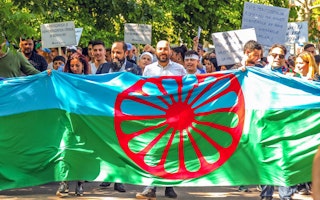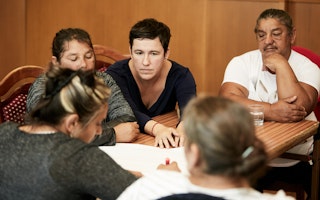OSI Stories: Young Roma Activists Target Education
By Bernard Rorke
Representatives of the continent’s 8 to 12 million Roma are mounting organized efforts to claim for their people the rights they have as citizens of the new Europe. Through the Decade of Roma Inclusion 2005-2015, an unprecedented initiative supported by the Open Society Institute and the World Bank, members of a new generation of Roma leaders are pressing the nine participating governments to meet their commitments to improve education as well as health care, housing, and employment opportunities.
With OSI’s support, a group of Roma activists, including Toni Tashev, a 35-year-old Roma lawyer who attended a segregated Roma school, formed a nongovernmental organization in Bulgaria, the Regional Policy Development Center, which participated in a Decade Watch monitoring project. The chief conclusion of the project’s report, Tashev says, is that in all the participating countries there is a significant lack of relevant data to assess government compliance with the commitments made in the Decade of Roma Inclusion.
“At the moment, we can only assess the inputs made by national authorities, and not the outcomes,” Tashev says.
The Open Society Institute and the World Bank also work through the Roma Education Fund to promote equal access to quality education for Roma children. OSI-backed research in Slovakia, along with a similar study by Amnesty International, led them to issue, in November 2007, an urgent call for the European Union to take action to end Slovakia’s discrimination against Roma children and its systematic violation of the right of Roma children to quality schooling.
OSI and Amnesty International also called upon the European Union to adopt an integrated policy on Roma and use all its legal and financial means to eradicate discrimination in European Union countries. Researchers discovered that segregation of Roma children in Slovakia had had a devastating impact upon the children themselves as well as upon the broader community and that a disproportionate number of Roma children in Slovakia were being placed in schools for children with mental disabilities or segregated into Roma-only schools.
“The problems that Roma face in Slovakia are so intertwined that only a comprehensive approach to solving all of them at the same time can bring real change,” says one of the researchers, 25-year-old Mirka Hapalova, director of the Slovakia branch of People in Need.
Asen Karagyozov, age 32, works at the Association of Roma Youth in Stolipinovo, a neighborhood of drab prefab-concrete apartment blocks, in Plovdiv, Bulgaria. Karagyozov and his father operate a program to bus Roma children from a segregated school in Stolipinovo to mostly elementary schools where most pupils are Bulgarian. Karagyozov arranges for Roma teaching assistants to accompany the children to school; he and his associates help obtain second-hand clothing for some children; on some mornings, he drives the bus. So far, about 200 Roma children participate in the desegregation program in Plovdiv. Another 3,300 attend a segregated school in the mahala.
“No Bulgarian would come here to Stolipinovo to go to school,” Karagyozov says. Živka Bošnakova, the mother of a Roma second-grader, knows why. “I went to that school,” she says. “I know my son reads, writes, and knows math better than children going there.”
In a landmark decision for Roma and members of other ethnic groups across Europe, the European Court of Human Rights ruled in November 2007 that segregating Roma students in “special” schools is a form of unlawful discrimination. The ruling came in a case filed, with OSI’s support, nine years earlier on behalf of 18 Roma children from the city of Ostrava who sought legal redress for the practice—widespread in Central and Eastern Europe—of shunting Roma students, regardless of their intellectual abilities, into “special” schools for children with learning disabilities.
Research undertaken by Ivan Ivanov, who, at the beginning of the trial was a 32-year-old a staff attorney at the OSI-sponsored European Roma Rights Center, showed that Roma pupils in Ostrava were 27 times more likely than similarly situated non-Roma pupils to be placed in “special” schools.
“There was no antidiscrimination legislation in Central and Eastern Europe at the time,” says Ivanov. “Now we can take this decision and present it in each country where there is segregation of Roma children. Segregation is discrimination. Period.”
Until December 2013, Bernard Rorke was international research and advocacy director for the Roma Initiatives Office.


